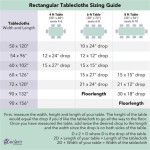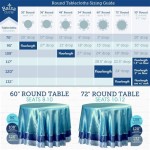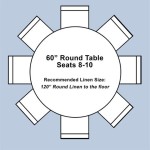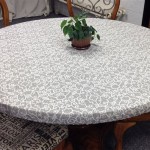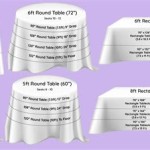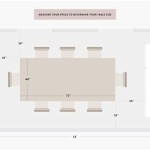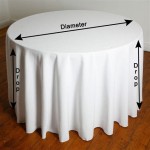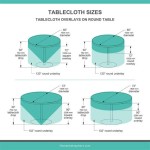How to Measure a Tablecloth for an Oval Tabletop with a Rectangle Overlay
Selecting the right tablecloth for an oval table presents a unique challenge, especially when incorporating a rectangular overlay for added style or protection. Accurately measuring the tabletop is crucial for ensuring the tablecloth and overlay drape gracefully and provide the desired aesthetic. This article provides a comprehensive guide to measuring an oval tabletop and determining the appropriate dimensions for both the base tablecloth and the rectangular overlay.
The process involves several key steps, including identifying the table's widest and longest points, determining the desired drop for the tablecloth, and calculating the final dimensions for both the oval and rectangular cloths. It is essential to consider the material properties of each fabric, as some materials may shrink or stretch after washing. Taking precise measurements and accounting for these factors will contribute to a polished and professional table setting.
Key Point 1: Measuring the Oval Tabletop Accurately
The foundation of selecting the correct tablecloth size lies in obtaining accurate measurements of the oval tabletop. Unlike a perfectly round or rectangular table, an oval shape requires specific measurements to ensure a proper fit. The two main dimensions to ascertain are the length and the width. The length is determined by measuring the longest distance across the tabletop, from one end to the other through the center. The width is the measurement of the widest point of the table, perpendicular to the length. It is crucial to use a flexible measuring tape for this task, as it can conform to the curved edges of the oval shape.
To begin, position the measuring tape at one end of the table's longest point. Ensure the tape runs straight and passes through the center of the table to the opposite end. Note the measurement in inches or centimeters, depending on the preferred unit of measurement. This measurement represents the length. Next, identify the widest point of the table, typically located halfway along the length of the table but this can vary depending on the oval's geometry. Position the measuring tape across the widest point, ensuring it is perpendicular to the length measurement. Record the measurement, representing the width.
Accuracy is paramount during this stage. It is advisable to take multiple measurements for both length and width to ensure consistency and identify any discrepancies. If there are variations in the measurements, average them to obtain the most accurate representation of the table's dimensions. Rounding the measurements to the nearest inch is generally acceptable for tablecloth selection, but for more precise overlays, fractions of an inch may be considered.
Consider the table's edge profile when measuring. If the table has a beveled or rounded edge, account for this in the measurements. The tablecloth will drape differently over a sharp edge compared to a rounded one. Ideally, measure from the outermost points of the table, including any curvature or beveling, to ensure the tablecloth provides adequate coverage.
Finally, document the measurements clearly, labeling them as "Length" and "Width." These figures will serve as the basis for calculating the required tablecloth size and the dimensions for the rectangular overlay.
Key Point 2: Determining the Desired Tablecloth Drop and Overlay Dimensions
Once the table's length and width are accurately measured, the next step is to determine the desired "drop" for the tablecloth. The drop refers to the amount the tablecloth hangs over the edge of the table. The ideal drop depends on personal preference and the overall aesthetic desired. Common drop lengths range from 6 to 12 inches, but formal settings may opt for a longer drop reaching the floor.
To calculate the total tablecloth dimensions, add the desired drop length twice – once for each side – to both the table's length and width. For example, if the table is 72 inches long and 48 inches wide, and a 10-inch drop is desired, add 20 inches (10 inches x 2) to both dimensions. This results in a tablecloth size of 92 inches by 68 inches. This calculation ensures the tablecloth drapes evenly on all sides of the oval table.
The rectangular overlay presents another measurement consideration. The overlay is typically smaller than the base tablecloth, allowing the base cloth to be visible and create a layered effect. The dimensions of the overlay depend on the desired amount of the base tablecloth to be exposed. Generally, the overlay should be narrower and shorter than the calculated tablecloth size, leaving a border of the base cloth visible around all edges.
To determine the overlay dimensions, subtract the desired border width from the calculated tablecloth dimensions. For instance, if a 6-inch border of the base tablecloth is desired on all sides, subtract 12 inches (6 inches x 2) from both the length and width of the calculated tablecloth size. Using the previous example, the tablecloth size is 92 inches by 68 inches. Subtracting 12 inches from each dimension results in an overlay size of 80 inches by 56 inches. This sized overlay will leave a 6 inch border of the base oval tablecloth visible.
Consider the placement of the rectangular overlay. It does not necessarily need to be perfectly centered. An off-center placement can create a more casual and contemporary look. If opting for an off-center placement, adjust the subtraction calculations accordingly to achieve the desired border widths on each side.
When selecting the size for the overlay, factor in the purpose of the overlay. If the overlay is intended to protect the base tablecloth from spills, ensure it provides adequate coverage of the area most prone to spills. If the overlay is primarily for aesthetic purposes, experiment with different sizes and placements to achieve the desired visual effect.
Key Point 3: Fabric Considerations and Final Adjustments
The type of fabric chosen for both the tablecloth and the overlay significantly impacts the final dimensions and overall appearance. Different fabrics have varying degrees of shrinkage, stretch, and drape. Natural fibers, such as cotton and linen, are prone to shrinkage after washing, while synthetic fibers, such as polyester, are generally more resistant to shrinkage but may stretch over time.
To account for potential shrinkage, pre-wash the fabrics before cutting and sewing. This allows the fabric to shrink to its maximum extent, ensuring accurate final dimensions. Alternatively, add an extra allowance for shrinkage during the measurement and cutting process. A general rule is to add 3-5% to the calculated dimensions for cotton and linen fabrics, depending on the fabric's weave and fiber content. This means that a 92-inch length would increase by approximately 2.76 to 4.6 inches, which is a range that should be accounted for either by initially purchasing more fabric, or by adjusting initial measurements.
The drape of the fabric also influences the overall appearance. Heavier fabrics tend to drape more smoothly and create a more formal look, while lighter fabrics may have a more casual and flowing drape. When choosing a fabric, consider the weight and texture in relation to the desired aesthetic and the table's overall style.
The choice of hem also affects the final dimensions. A narrow hem will add less length to the tablecloth and overlay than a wider hem. Factor in the hem allowance when cutting the fabric to ensure the finished dimensions match the calculated measurements. Typically, a double-folded hem is recommended for durability and a clean finish. Experiment on scrap fabric before the final finishing to see how large of a hem is preferable.
Before finalizing the fabric cuts, it is prudent to create a mock-up using inexpensive fabric or paper. This allows for a visual confirmation of the dimensions and drape before committing to the final fabric. Drape the mock-up over the table to assess the fit and make any necessary adjustments to the measurements.
Finally, carefully consider the color and pattern of both the tablecloth and the overlay. Choose colors and patterns that complement the table's surroundings and the overall decor of the room. A solid-colored tablecloth provides a versatile base for a patterned overlay, while a patterned tablecloth can be paired with a solid-colored overlay for a more understated look. Ensure that the fabrics chosen are of compatible weight. An overlay that is too heavy for the base will drag the base cloth and look unseemly.
By meticulously following these steps and considering all relevant factors, selecting the correct tablecloth size for an oval table with a rectangular overlay becomes a manageable task. Accurate measurements, careful calculations, and thoughtful fabric selection will result in a beautifully adorned table that enhances the dining experience.

Tablecloth Size Calculator Williams Sonoma Taste

Tablecloth Size Calculator Williams Sonoma Taste

How To Measure For A Tablecloth 2 Easy Methods

Let S Talk Linens The Ultimate Guide To Table Linen Sizes Party Al Ltd Pink Hippo Blog

Let S Talk Linens The Ultimate Guide To Table Linen Sizes Party Al Ltd Pink Hippo Blog

Luxury Damask Fabric Tablecloth 100 Polyester Waterproof Anti Wrinkle Rectangle Table Cover For Tabletop Decoration Indoor Outdoor Use 60 X 102 Dark Grey Com

Made To Measure Square Rectangular Star Tablecloths Express Textiles

Rectangle Table Cloth Cotton Dining Decoration Birthday Wedding 90 X 132 Inch White 1 For

N Table Cloths Country Tablecloth Block Print Cotton Blue Cloth Moroccan Tile

Choosing The Right Tablecloth Size Cv Linens
Related Posts

